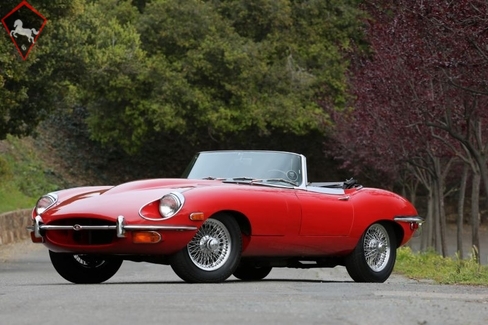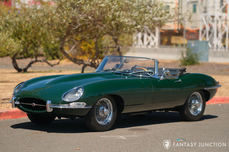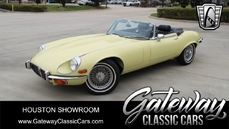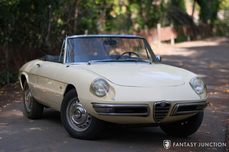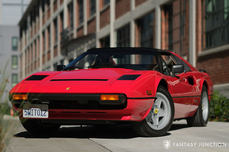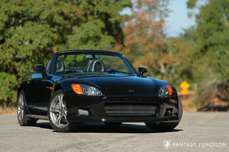Jaguar E-type 4.2 Liter Inline-6 1969
General description :
1969 Jaguar E-Type Series II
s/n 1R10726, engine no. 7R7273-9
Red with Black Leather
The E-Type was unveiled in March of 1961 at the Geneva Motor Show, following the famous 11th hour disorder (one of the cars was driven to the show from England with just hours to spare). The car was an immediate sensation: its specification was state of the art, its bodywork arrestingly gorgeous, and the price surprisingly affordable. It embodied William Lyons’ values beautifully and it is no surprise that the E-Type has become so iconic. The specification clearly demonstrated Jaguar's racing experience and included independent suspension all around (at a time when Ferrari was still using live rear axles), disc brakes all around (inboard at the rear to reduce unsprung weight), and of course Jaguar's legendary twin cam inline-6. Sales were brisk and the cars were continuously developed.
For the 1969 model year, the Series II arrived, which was substantially the same mechanically as the Series I, but featured a number of safety improvements to satisfy new American legislation. The Series II contained much of the charm of the Series I without the heaviness of the later Series III cars. Series II updates included improved cooling thanks to a larger intake opening, improved lighting, open headlight buckets, and full-width rear bumper.
The first owner purchased this car in Atlanta, Georgia, selling it to the second owner March 15th, 1977. The third owner is then known to have purchased the car June 20th, 1989. He retained the car for more than twenty years, selling it in 2012. During his long-term ownership, the car spent the vast majority of its time in the Metro Atlanta area was restored with attention to detail using quality British parts. The red paint was applied over properly prepared bodywork with selected rust repair limited to the driver’s foot box and the jacking points. On February 19th, 1977 the Georgia State Inspection reported the last known miles on the car at 22,165. Records for the restoration begin October 10th, 1977, but upon completion of the restoration, the odometer was reset to zero in 1987, accounting for the current mileage of 4,677. During the restoration, the head was removed and replaced with a Series III XJ6 head. These later heads have larger valves and breathe better than the earlier heads, which improves performance. Additionally the car was converted to the triple SU carburetor configuration of the Series I cars (US spec Series II cars originally had twin Stromberg carburetors for emissions reasons).
After the restoration was completed, the owner used it sparingly, accounting for most of the currently indicated 4,600 miles, until it was brought to Speedwell garage (in about 2012) for mechanical freshening and sorting as needed. The fuel tank was removed, boiled out, sealed, and the pick up screen and plastic fuel lines were replaced. The intake manifold was removed and the carburetors were rebuilt including new jets and floats. At that time, the cylinder head was also removed and a valve job performed, which included inspecting it for cracks, decking, and fitting hardened valve seats. With the head off, the exhaust was sent out and Jet-Hot ceramic coated while the inlet manifold was reconditioned as well. All fluids were drained and renewed. The distributor was removed and sent to Jeff Schlemmer at Advanced Distributors who rebuilt and re-curved the distributor to allow for matched specifications to the triple carburetor set up. The brakes were flushed as well as the clutch hydraulics. All four ball-joint gaiter boots were replaced and all fittings were lubed and greased including front and rear wheel bearings. Concluding this service work, the car received four new Vredestein 185HR15 Sprint tires and a new battery. Before concluding mechanical systems a few minor electrical issues were tended to as well. All systems in place and ready to go, the compression was checked and all 6 cylinders found to be at 150 psi. The car comes with records back to 1975 and three photo books of documentation, which depict the engine work and other maintenance performed over the years.
Today, this Jaguar presents as an attractive and very honest example which benefits from much restoration work having been done to high standards some years ago, but still presenting as a well maintained and visually pleasant example. The paint is glossy and was nicely done but now shows blemishes from age and use on most panels. The chrome is nicely presented overall but has some hazing in areas, though very much in keeping with the overall presentation. The black vinyl top is sound and in nice condition, appearing to have had only minimal use. The wheels are in very nice condition, still shod with the Vredestein Sprint tires, installed in 2012, approximately 300 miles ago. The lights and glass are in very good condition as well with nice presentation, again in keeping with the quality driver level condition of the car overall.
The interior is in very good shape. The leather seats were reupholstered as part of the restoration thirty years ago and now display a lovely, soft patina. The console and dashboard upholstery are very nice, as are the carpets, all of which were done with high quality materials, which have been afforded thoughtful preservation over time. The steering wheel has the correct appearance and nicely finished aluminum spokes with a handsome and iconic center emblem. The instruments, switches, and controls are in very nice shape as well, once again contributing to the look and feel of an attractive driver level sports car.
The engine compartment is generally very clean and nicely detailed, but not to show standards. The handsome triple SU carburetor setup is a meaningful visual upgrade over the original twin Strombergs, in addition to providing higher performance as well. The engine itself is clean and nicely detailed, while the suspension shows just mild evidence of road use. Overall the engine and engine compartment are nicely finished and properly presented with a few improvements and upgrades to improve the car’s usability. The trunk has been properly finished with a nice tan ambla material, housing a full sized wire wheel and factory specification tool roll. The undercarriage reveals a clean and tidy car that has seen road use but still maintains a very presentable level of detail, with the exception of normal wear on a few painted cast metal surfaces.
One of the added benefits of the later Series II cars is the improved driver ergonomics and their ability to accommodate larger drivers, which contributes greatly to the driving experience. The engine starts easily, runs smoothly on idle and makes excellent power with good oil pressure. The transmission shifts up well through all gears, with good brakes and suspension around town and at highway speeds. The steering, brakes, and suspension all have a very good, harmonious feel, having benefited from proper care and service over the years.
The car comes with several spare parts including the original twin carburetor intake manifold (complete with carbs and air filter mount), an earlier series cylinder head, tool roll, tools, hammer, jack, and knock off spanner. A spare set of pistons and assorted mechanical parts are also included and are assumed to be original to the car. Also included are copious amounts of documents, receipts dating back to 1975, numerous photos of the restoration, an original owner’s manual, service manual, various parts books, and assorted Jaguar specialty literature.
This is an excellent opportunity to acquire a great driving, solid, and honest E-Type Roadster with long-term ownership history. This Jaguar is a strong value compared to the Series I Roadster, particularly given the improved triple-carburetor setup in this roadster. For anyone seeking a fine driving and evocative example of this motoring icon, this is an ideal example to use extensively without fear of ruining a fresh restoration.
http://fantasyjunction.com/cars/2093-Jaguar-E-Type%20Series%20II%20Roadster-4.2%20Liter%20Inline-6
1969 Jaguar E-type 4.2 Liter Inline-6 is listed sold on ClassicDigest in Emeryville by Fantasy Junction for Not priced.
Car Facts
Car type : Car Make : Jaguar Model : E-type Model Version : 4.2 Liter Inline-6 Engine size : 4.2 Model Year : 1969 Location : Emeryville
Sold
Seller Information
Sold
People who viewed this Jaguar E-type also viewed similar Jaguar listed at ClassicDigest
Other cars listed for sale by this dealer
About Jaguar E-type
The Jaguar E-Type FHC (Fixed Head Coupe) is a classic sports car that was produced by the British automaker Jaguar Cars from 1961 to 1974. It is often regarded as one of the most beautiful cars ever produced, with its long, sleek hood, flowing curves, and aggressive stance.The E-Type FHC was derived from the D-Type race car that won the 24 Hours of Le Mans in 1955, 1956, and 1957. It was powered by a 3.8-liter inline-six engine that produced up to 265 horsepower and featured advanced suspension and braking systems, with independent suspension and disc brakes on all four wheels.
The E-Type FHC was known for its exceptional handling and performance, with a top speed of up to 150 mph and acceleration from 0 to 60 mph in as little as 6.7 seconds. Its design was also innovative for its time, featuring an independent rear suspension and a monocoque construction.
The Jaguar E-Type FHC became an iconic car of the 1960s and was favored by celebrities and enthusiasts alike. OTS i.e The Jaguar E-Type Roadster became an iconic car of the 1960s and was favored by celebrities wanting to be seen in their car.
